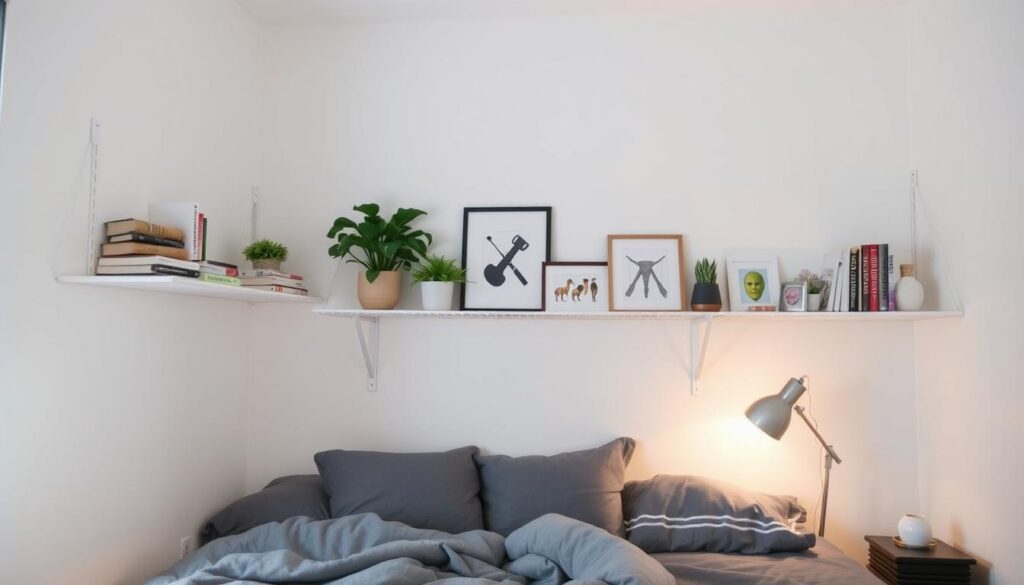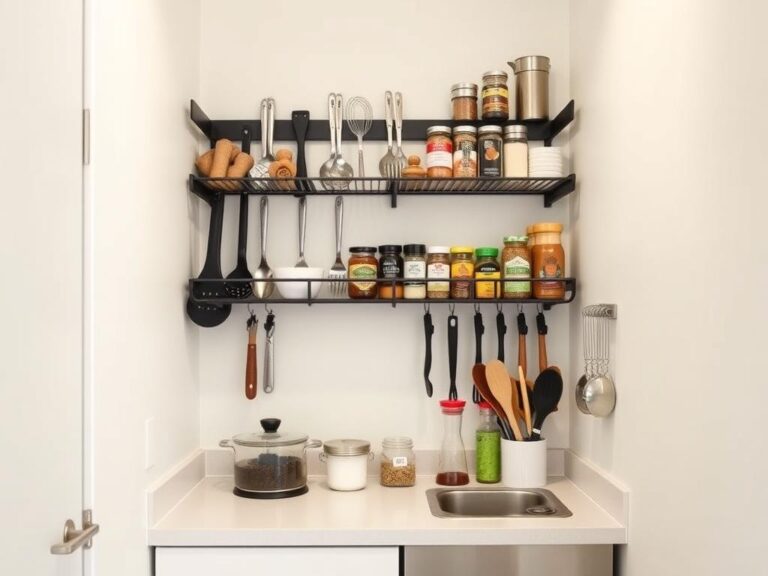7 clever ways to use tension rods in your dorm
Discover 7 clever ways to use tension rods in dorm rooms to maximize space and organization. Learn how to optimize your dorm room setup today.
Adjustable spring-loaded tools offer damage-free customization for student housing. These versatile items cost between $5 and $25, fitting tight budgets while solving common challenges in temporary living arrangements. Their twist-to-expand design creates secure pressure between walls without screws, hooks, or permanent alterations.

College residents often struggle with strict housing rules that forbid wall modifications. Spring-mounted organizers help create privacy zones and storage areas while keeping security deposits safe. This guide shows how to transform blank walls and awkward corners into functional spaces for studying and relaxing.
The right setup turns institutional environments into personalized areas. From window treatments to room dividers, these tools support multiple creative applications. Students can maximize vertical space without risking fines or property damage.
Key Takeaways
- Affordable alternative to permanent fixtures
- No tools required for installation
- Protects walls from marks or damage
- Creates instant privacy screens
- Works with standard curtain panels
- Adapts to various room layouts
- Avoids end-of-year repair charges
Introduction to Dorm Room Curtain Solutions
Navigating dormitory rules while achieving privacy and style calls for non-destructive curtain strategies. Many student housing units feature concrete surfaces and strict no-drill policies, turning simple upgrades into logistical puzzles. Window treatments become essential for managing light exposure and creating personal zones in shared quarters.
Understanding Housing Limitations
Concrete walls reject standard screws and nails, while lease agreements often forbid permanent alterations. Early sunlight or bright hallway fixtures can disrupt sleep patterns and study sessions. Shared living spaces amplify the need for visual separation without permanent room dividers.
Why Non-Permanent Methods Matter
Damage-free installations protect security deposits and prevent disciplinary actions. Proper window coverings help regulate room temperature and block unwanted glare on computer screens. Students report better focus and relaxation in spaces they can customize safely.
What Else Would You Like to Know?
Choose below:
| Installation Method | Average Cost | Ideal For |
|---|---|---|
| Adhesive Hooks | $4-$8 | Lightweight panels |
| Spring-Loaded Systems | $10-$18 | Wider windows |
| Magnetic Options | $12-$25 | Metal window frames |
Quality curtains dorm residents choose can reduce noise by up to 40% while maintaining compliance with housing guidelines. Temporary solutions allow easy adjustments as needs change throughout the academic year.
Innovative Uses of Tension Rods in Dorm Rooms
Transform tight spaces into functional zones with pressure-mounted tools that adapt to student needs. These spring-loaded helpers do more than hang curtains—they create smart storage and privacy solutions. Their twist-and-lock mechanism works between walls, cabinets, or other flat surfaces without hardware.

Maximizing Space with Adjustable Tension Rods
Create instant room dividers by mounting rods horizontally across corners. Use fabric panels or string lights for visual separation in shared areas. Vertical installations inside closets organize shoes, accessories, or cleaning supplies.
| Application | Required Length | Best For |
|---|---|---|
| Room Divider | 6-8 ft | Shared living areas |
| Closet Organizer | 2-4 ft | Shoes & accessories |
| Shower Caddy | 18-24 in | Bathroom storage |
Tips for a Secure, No-Damage Setup
Clean surfaces with rubbing alcohol before installation for better grip. Add rubber caps to both ends to prevent slipping. For heavy items like plants, use multiple rods to distribute weight evenly.
Angle the rod slightly upward during easy install to increase friction. Test stability weekly—adjust tension if needed. Avoid placing near heat sources that could weaken materials over time.
Damage-Free Curtain Hanging Methods
Students need window treatments that protect walls and security deposits. Modern solutions combine professional stability with easy install remove features. These methods work on various surfaces while complying with strict housing policies.
Kwik-Hang Brackets: Heavy-Duty Support
Patented Kwik-Hang brackets handle up to 20 pounds—ideal for blackout curtains. Position them on wooden window frame trim and tap gently with a hammer. No screws or drills required. Double brackets cost $15.99, offering layered curtain options.
3M Command Hooks: Lightweight Versatility
For sheer panels or lightweight fabrics, use large command hooks. Clean surfaces with alcohol wipes before applying adhesive strips. Space hooks 1″ wider than your curtain rod for secure placement. Remove by pulling the tab downward to prevent paint damage.
| Method | Weight Capacity | Price Range | Best For |
|---|---|---|---|
| Kwik-Hang | 20 lbs | $12.99-$15.99 | Heavy drapes |
| Command Hooks | 5 lbs | $6-$10 | Sheer fabrics |
Both options let you hang curtain rod systems without damaging walls. Kwik-Hang works on wooden trim, while Command Hooks adhere to painted surfaces. Choose based on curtain weight and window frame material.
These solutions save $150+ in potential repair fees. They create polished looks that mimic permanent installations. Rotate curtains seasonally while keeping surfaces intact.
Alternative Curtain Rod Solutions for Dorms
Upgrade your window treatment game with advanced mounting systems that blend stability and style. These solutions work where basic setups fall short, offering secure installations for heavier fabrics or unique architectural features.
Exploring Twist and Fit Curtain Rods
Twist fit curtain systems combine adjustable length with locking brackets. They grip window trim tightly, supporting medium-weight drapes better than standard options. Perfect for bay windows or uneven frames found in older buildings.
Installation takes under three minutes. Rotate the end brackets until they click into place on the trim. Prices start at $19.99 for basic models. Premium versions include decorative finials and rust-proof coatings.
Embracing Magnetic Curtain Rod Options
Metal-framed window openings get new life with magnetic alternatives. These curtain rods use industrial-strength magnets that hold up to 8 pounds. Ideal for temporary room dividers or layered curtains setups.
For maximum stability:
– Use paired rods at top and bottom
– Clean metal surfaces with vinegar first
– Avoid silk or velvet fabrics
| Feature | Twist & Fit | Magnetic |
|---|---|---|
| Weight Limit | 12 lbs | 8 lbs |
| Install Time | 2 minutes | 45 seconds |
| Best For | Wood trim | Metal frames |
Both options preserve window surfaces while creating polished looks. Magnetic systems excel in spaces with steel door frames, while twist-fit models handle ornate trim better. Choose based on your window treatment needs and architectural features.
Maximizing Privacy and Space in Your Dorm Room
Elevate your living area with ceiling-mounted systems that redefine personal boundaries. Shared quarters demand solutions that create separation without permanent alterations. Strategic window treatment installations can carve out private zones while preserving square footage.
Curtain Strategies for Enhanced Privacy
Choose blackout curtains with light-filtering liners for layered light control. Breathable fabrics like linen blends maintain airflow while blocking visual access. For bed areas, install ceiling-mounted panels that drape to the floor—this vertical approach saves floor space better than traditional room dividers.
| Hook Type | Weight Capacity | Best Use |
|---|---|---|
| Adhesive Hooks | 5 lbs | Sheer panels |
| Magnetic Hooks | 8 lbs | Metal ceilings |
| Screw-Free Anchors | 12 lbs | Heavy blackout curtains |
Creative Ideas Using Ceiling Hooks as Room Dividers
Transform open layouts using suspended curtain tracks. Create study nooks by framing desk areas with noise-reducing drapes. For changing stations, use U-shaped configurations with hooks placed 6″ beyond shoulder width.
Pair material choices with function: velvet for sound dampening, mesh for visual barriers with airflow. Always test adhesive strength on small ceiling areas first. Remove hooks using the manufacturer’s release tabs to prevent surface damage.
Conclusion
Transforming student spaces requires clever solutions that respect housing policies. The damage-free installations outlined in this guide prove you don’t need permanent fixtures to create functional, stylish areas. From magnetic systems for metal frames to twist-fit options for wooden trim, every method protects surfaces while maximizing utility.
Choosing the right window treatments impacts both productivity and comfort. Light-blocking panels improve sleep quality, while strategic room dividers foster better focus during study sessions. These temporary setups adapt as needs change – swap sheer curtains for blackout versions during exam weeks without damaging walls.
Students can personalize their environment using seven tested approaches from this guide. Whether creating privacy around bunk beds or organizing supplies near the door, each solution prioritizes easy install and removal. Proper implementation helps avoid security deposit deductions while supporting academic success through improved living conditions.
Experimentation within policy guidelines leads to spaces that feel like home. Start with lightweight fabrics and basic hooks, then explore advanced systems as confidence grows. Every adjustment brings you closer to an optimized environment where functionality meets self-expression.
FAQ
Can I hang curtains in a dorm without drilling holes?
How do I keep heavy blackout curtains from falling in a dorm?
Are magnetic curtain rods safe for rented spaces?
What’s the best way to divide a dorm room for privacy?
Can I reuse curtain hardware when moving out?
Do Kwik-Hang brackets work on all window types?
How do I prevent curtains from blocking natural light?
Tiny Kitchen, Big Ideas: Organizing Your Small Student Kitchen
» See exclusive tips for your home








